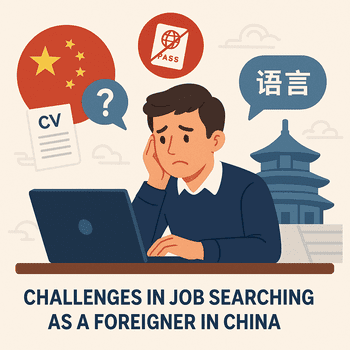
China remains a significant global economic power with diverse opportunities for international talent.
However, the landscape for foreign job seekers has transformed dramatically in recent years.
This guide provides current insights into China’s job market for foreigners, addressing recent policy changes, regional differences, and practical strategies based on the latest data and trends.
1. Understanding China’s Current Work Visa Framework
China’s work permit system underwent major reforms in 2023-2025, introducing more stringent requirements while creating new pathways for qualified professionals.
Current Work Permit Categories (2025)
| Category | Points Required | Target Professionals | Annual Quota |
|---|---|---|---|
| Class A (High-end talent) | 85+ points | Senior executives, scientists, specialized technical experts | No quota limit |
| Class B (Professional talent) | 60-84 points | Mid-level managers, engineers, teachers with experience | Subject to quota |
| Class C (Non-technical workers) | Below 60 points | Service industry, entry-level positions | Highly restricted |
Recent Policy Changes:
- The points threshold for Class B increased from 60 to 70 points in January 2025
- New “Digital Economy Talent” subcategory added with specialized requirements
- Remote work visa pilot program launched in Shanghai, Hainan, and Greater Bay Area
Sources:
How to Navigate the System:
- Calculate your eligibility score using the official Work Permit Calculator
- Prepare documentation early – authentication processes now take 2-3 months in most countries
- Consider regional advantages – the Hainan Free Trade Zone offers streamlined visa processes for certain industries
2. Regional Job Market Variations
Job opportunities and salary expectations vary significantly across China’s diverse regions.
City Tier Comparison (2025 Data)
| City Tier | Average Foreign Salary Range (Monthly) | Industries Hiring Foreigners | Foreign Population |
|---|---|---|---|
| Tier 1 (Beijing, Shanghai, Guangzhou, Shenzhen) | ¥20,000-45,000 ($2,800-6,300) | Finance, Tech, Education, Consulting | 400,000+ |
| New Tier 1 (Hangzhou, Chengdu, Nanjing) | ¥15,000-30,000 ($2,100-4,200) | Tech, Education, Manufacturing, Tourism | 150,000+ |
| Tier 2 (Suzhou, Xiamen, Wuhan) | ¥12,000-25,000 ($1,700-3,500) | Education, Manufacturing, Trade | 50,000+ |
| Tier 3+ (Smaller cities) | ¥8,000-18,000 ($1,100-2,500) | Education, Specialized Manufacturing | Under 10,000 |
Regional Hiring Trends:
- Shanghai and Greater Bay Area: Leading in finance, tech, and creative industries
- Beijing: Government relations, education, and research positions
- Western China (Chengdu, Chongqing): Emerging tech hubs with lower competition
- Hainan: Tourism and hospitality with special visa policies
Source: China Foreign Talent Market Report 2025 and Randstad China Salary Guide
3. Industry-Specific Opportunities and Challenges
The demand for foreign talent varies dramatically by sector, with some industries expanding opportunities while others contract.
Industry Outlook for Foreign Professionals (2025)
| Industry | Hiring Trend | Key Roles for Foreigners | Visa Difficulty |
|---|---|---|---|
| Education | Declining ↓ | International school teachers, university professors | Moderate |
| Technology | Growing ↑ | AI specialists, product managers, senior developers | Low for experts |
| Finance | Stable → | Risk analysts, compliance officers, wealth management | High |
| Healthcare | Growing ↑ | Medical researchers, specialized physicians | Very high |
| Manufacturing | Declining ↓ | Quality control, supply chain management | High |
| Creative | Growing ↑ | UX/UI designers, marketing strategists, content creators | Moderate |
Industry Insights:
- Education: New regulations require master’s degrees and 2+ years of experience for teaching positions
- Technology: China’s 14th Five-Year Plan prioritizes foreign experts in semiconductor, AI, and biotechnology
- Creative industries: Growing demand for professionals who understand both Western and Chinese markets
4. Language Requirements and Reality
While English-speaking positions exist, language expectations have evolved significantly.
Language Requirements by Position Type
| Position Level | Mandarin Expectation | English-Only Viability | Industry Exceptions |
|---|---|---|---|
| Entry-level | HSK 4-5 typically required | Very limited | International schools |
| Mid-level | HSK 3-4 with industry vocabulary | Possible in MNCs | Tech startups, foreign trade |
| Senior/Executive | Business proficiency beneficial but not always required | Viable with translator support | Finance, consulting |
Language Strategy:
- Invest in at least HSK 3 level Mandarin (approximately 600 characters)
- Use platforms like HelloTalk or iTalki for language exchange
- Consider specialized business Mandarin courses through Mandarin Morning or GoEast Mandarin
5. Salary Expectations and Compensation Realities
The “expat package” era has largely ended, with compensation now more closely aligned to local standards with modest premiums.
Compensation Components to Consider
| Component | Current Trend | Negotiation Potential |
|---|---|---|
| Base Salary | 15-30% premium over local rates | Moderate |
| Housing Allowance | Decreasing, now typically 3,000-8,000 RMB/month | High |
| Health Insurance | International coverage becoming rare | Low |
| Relocation Package | One-time payment rather than ongoing benefits | Moderate |
| Tax Equalization | Now rare except for senior executives | Very low |
Tax Considerations:
- China’s Individual Income Tax reforms (2023) removed many exemptions for foreigners
- New tax residency rules apply after 183 days in country
- Consult resources like PwC China Tax Guide
6. Effective Job Search Strategies for 2025
The methods for finding employment have evolved significantly, with digital platforms dominating the landscape.
Top Job Search Platforms for Foreigners
| Platform | Primary Industries | Chinese Required | Success Rate |
|---|---|---|---|
| LinkedIn China | MNCs, Tech, Finance | No | Moderate |
| 51Job International | Various | Yes | High |
| Boss Zhipin | Tech, Startups | Yes | High |
| eChinacities Jobs | Education, Entry-level | No | Moderate |
| WeChat Recruitment Groups | Various | Yes | High |
Recruitment Agencies Specializing in Foreign Placement:
7. Addressing Discrimination and Bias
While rarely discussed openly, various forms of discrimination affect job searches for foreigners.
Common Bias Factors and Mitigation Strategies
| Bias Type | Industries Affected | Mitigation Strategy |
|---|---|---|
| Age (preference for 25-40) | Education, Marketing | Emphasize recent experience and energy |
| Nationality preferences | Education, Customer-facing roles | Network through country-specific chambers of commerce |
| Appearance expectations | Sales, Hospitality | Professional photos and appearance in interviews |
| Gender bias | Engineering, Executive roles | Leverage professional women’s networks |
Legal Protections:
- China’s Employment Promotion Law technically prohibits discrimination
- In practice, seek support through foreign chambers of commerce or consular services
8. Contract Considerations and Workplace Norms
Understanding Chinese employment contracts is essential for protecting your interests.
Standard Contract Elements to Verify
| Contract Component | Chinese Norm | Red Flags |
|---|---|---|
| Probation Period | 1-3 months | Anything beyond 6 months |
| Working Hours | “996” common in tech (9am-9pm, 6 days) | Unpaid overtime expectations |
| Termination Notice | 30 days standard | Less than 30 days notice |
| Non-compete | 1-2 years with compensation | No compensation for restrictions |
| Visa Responsibility | Employer handles process | Employee paying visa costs |
Contract Resources:
9. Remote Work and Digital Nomad Options
China has begun experimenting with remote work visas in specific regions.
Remote Work Possibilities
| Program | Location | Requirements | Duration |
|---|---|---|---|
| Shanghai Digital Professional Visa | Shanghai | Proof of employment, minimum income | 1 year, renewable |
| Hainan Free Trade Port Work Permit | Hainan Province | Digital skills, company registration | 2 years |
| Greater Bay Area Talent Scheme | Shenzhen, Guangzhou | Tech industry focus | 1 year |
Remote Work Resources:
10. Post-COVID Realities for Foreign Workers
The pandemic permanently altered China’s approach to foreign talent.
Key Post-COVID Changes
| Aspect | Pre-COVID | 2025 Reality |
|---|---|---|
| Entry Requirements | Relatively open | Health checks, additional documentation |
| Foreign Population | ~900,000 | ~600,000 (33% reduction) |
| Industry Priorities | Broad hiring | Strategic sectors only |
| Salary Premiums | 30-50% above local | 15-30% above local |
| Remote Collaboration | Limited | Hybrid models common |
Current Entry Requirements:
- China Visa Application Center provides updated entry policies
- Health codes and testing requirements vary by province
Conclusion
While China’s job market for foreigners has become more selective, qualified professionals with the right skills, realistic expectations, and strategic approach can still find rewarding opportunities.
The key is understanding the evolving landscape, preparing thoroughly, and leveraging both digital and personal networks effectively.
Additional Resources:


